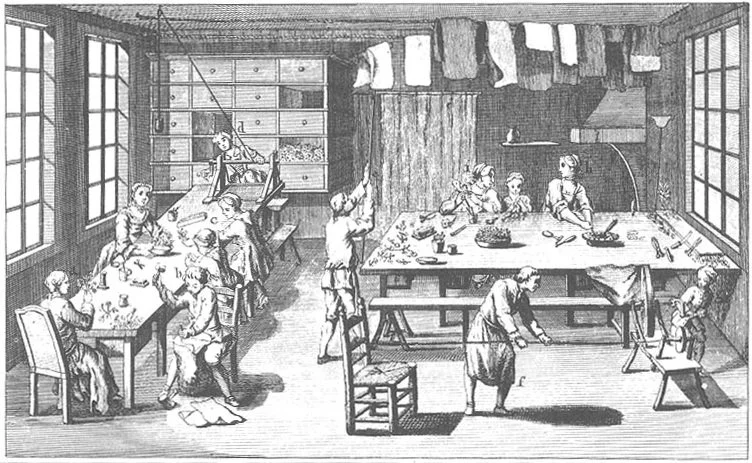18th Century Artificial Flowers
Flowers depicted on dresses, in hats, or in headdresses were probably artificial.
The flowers tumbling out of the small trunk in front of Miss Rattle dressing for the Pantheon (1772) seem to be artificial flowers for embellishing her hair and her gown.
Additional Resources
Conservation treatment of artificial flowers from the 18th century, Part 1 and Part 2
Artificial Flowers in the Credit Records of an Eighteenth-Century French Fashion Merchant
The History of Artificial Flowers: How Did It All Start?
Pretty Posies: The Colonial Revival’s Influence on the Use of Flowers in Historic Interiors
Fleuriste Artificiel
(The Maker of Artificial Flowers)
A workshop where several male and female workers and children are variously occupied in making artificial flowers; one in a is arranging flowers together, one in b is cutting them out with cutters, others in c are making flowerbuds, a female worker in d is embossing with the embossing machine, one in e is spreading out the vellum, canvas, or other fabric; one in f is wrapping the vellum around the wire, while a young boy in g is busy turning the wheel of the spinning machine; a woman in h is embossing with an iron, and the others in i are making flowerbuds, assembling flowers, etc.
From the Encyclopédie ou Dictionnaire raisonné des sciences, des arts et des métiers (1765).
For more (including patterns for petals and leaves, and diagrams for the tools involved with making artificial flowers), see the ARTFL Encyclopédie.
Trade Cards for Manufacturers of Artificial Flowers
© The Trustees of the British Museum. Shared under a Creative Commons Attribution-NonCommercial-ShareAlike 4.0 International (CC BY-NC-SA 4.0) licence.
Extant examples
Colonial Williamsburg has several flowers from the 17th or 18th centuries, including 1952-513, 1952-514, 1952-515, 1952-516, 1952-518, 1952-519, 1952-522
V&A T.251 to C-1959 is a gown decorated with artificial flowers. (See also the notebook pages on ribbon embroidery and fly fringe.)
MFA 43.1833, an 18th century French straw hat with silk artificial flowers
Assorted notes on artificial flowers
Some notes on confectioners’ artificial flowers. Recipes & instructions for making artificial flowers can be found in several sources, including The Lady’s Companion and The Experienced English Housekeeper. V&A W.11-1949 is a mold that confectioners could use to make similar ornaments for the dining table. See also A Feast for the Eyes: 18th-century documents for the creation of a dessert table.
Manuscript notebook on textile dyeing and the manufacture of artificial flowers, with a collection of patterns and designs by Maria Placida Bens, c. 1743; see also The Artificial Flowers Project
“Ladies inſtructed in Embroidery; Cloth-work raiſed and flat, from the beſt deſigns; Tambour, Pearl,Filagree, Wafer, and Print Work; Artificial Flowers; a moſt curious Embroidery in Trom Silk, at 2s. 6d. per Leſſon; and at Ladies own houſes, at 5s. per Leſſon. Materials for all kinds of Work furniſhed. A great aſſortment of Artificial Flowers for ſale, and the price marked on each article.” (The Times, June 12, 1787)
The trial of Renwick Williams on July 8, 1790, has some descriptions of a flower-making business. (Additional description of Williams and his crimes in The Historical Magazine: “Monster.”)
Vanuxem and Lombaert advertised the sale of “an elegant Assortment of Feathers and Artificial Flowers” at their store (“No. 79, North Water-ſtreet”) in Philadelphia in several newspapers around 1792
“Though not a merchant, yet it will not be out of place to mention the
son of an old New Yorker, who was old John Vache, and was the first
artificial flower merchant and manufacturer that ever lived in New York. He
commenced his business at 28 Liberty street in 1790, and he continued it
there until he moved to Newark in 1827.” (The Old Merchants of New York City, 1863)
Also noted in The Cox Family in America:
“John Vache, b. in Orleans, France, a dealer in feathers and artificial flowers, at 28 Liberty St., where he also lived.”
His trade is referenced in several newspapaper advertisements in the 1790s, including:
“John Vaché, ARTIFICIAL-FLEURIST From New-York, where he has reſided for ſome years paſt, HAS for ſale at Mr. F. Serre’s houſe in ſecond-ſtreet No. 193, near the New-Market, the following Articles, viz. Artificial Flowers of all kinds; Oſtrich-Feathers, white and black, flat and round; Feathers of all colours, which he can alter to ſuitt he fancy of the Ladies. Ladies’ white and coloured Gloves; Silk Stockings of all colours, hair ribbons, black Sattin for breeches, &c. &c.” (Aurora General Advertiser, December 6, 1790)
“JOHN VACHE ARTIFICIAL FLEURIST, from New-York, No. 23 Third-ſtreet between Market and Cheſnut ſtreet, INFORMS the Ladies of Philadelphia, that he has brought with him a large aſſortment of Artificial Flowers, White and Black Oſtrich Feathers — and a great variety of other Feathers, — which he will work according ot their taſte or fancy” (Aurora General Advertiser, March 1, 1792)
“LAWRENCE MAREY, Ladies Hair-Dresser … has alſo received from Mr. J. Vaché, Artificial Floweriſt in New-York, a large aſſortment of artificial flowers, of all kinds, white and black Oſtrich feathers (flats and rounds) and other fancy do. which articles he will ſell at a moderate price.” (Aurora General Advertiser, November 27, 1792)




